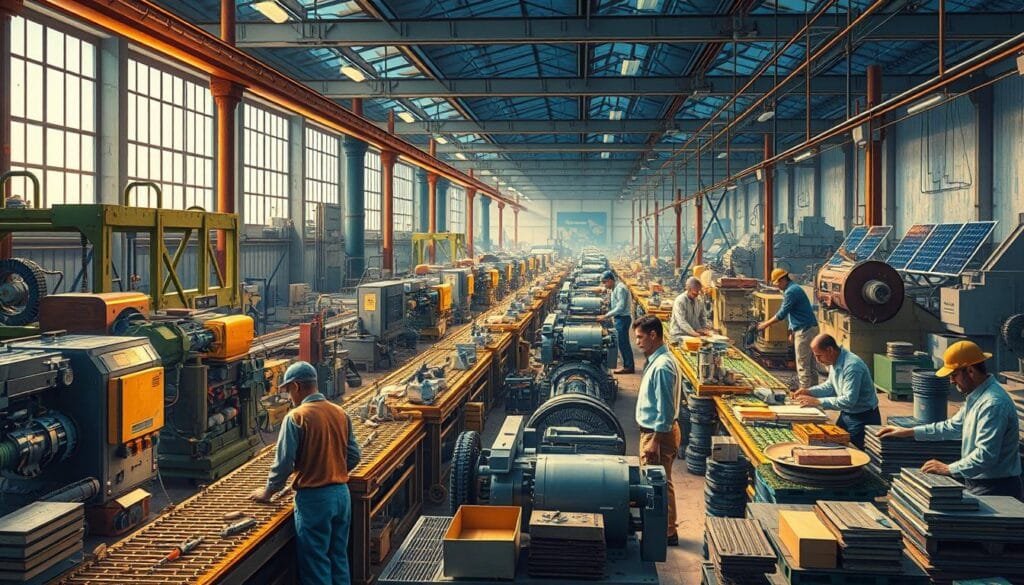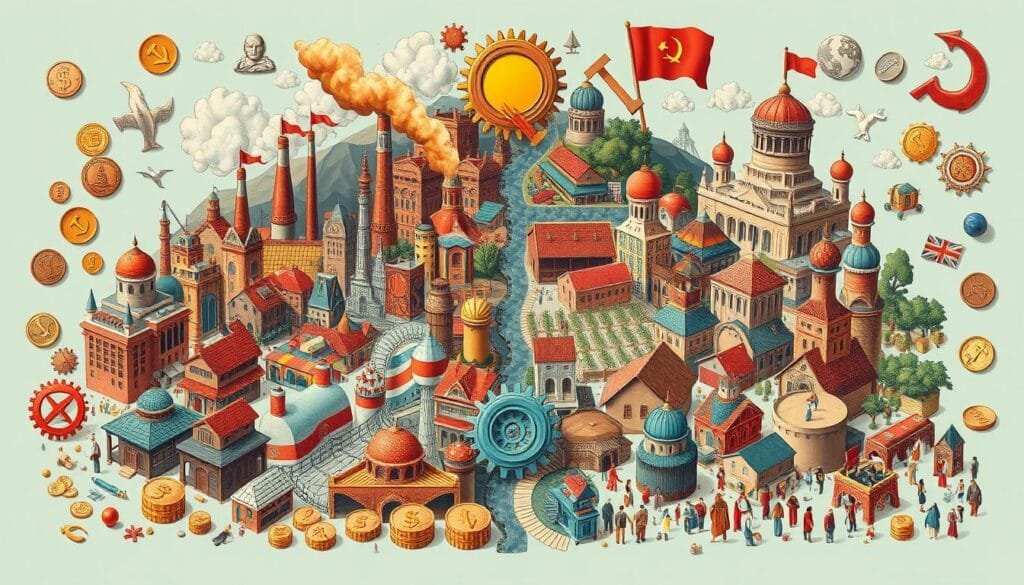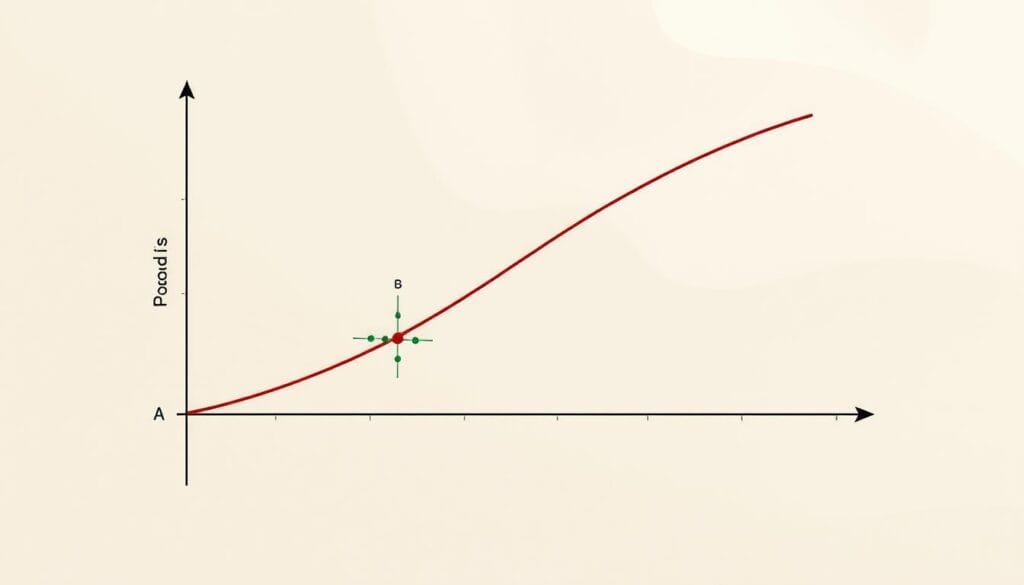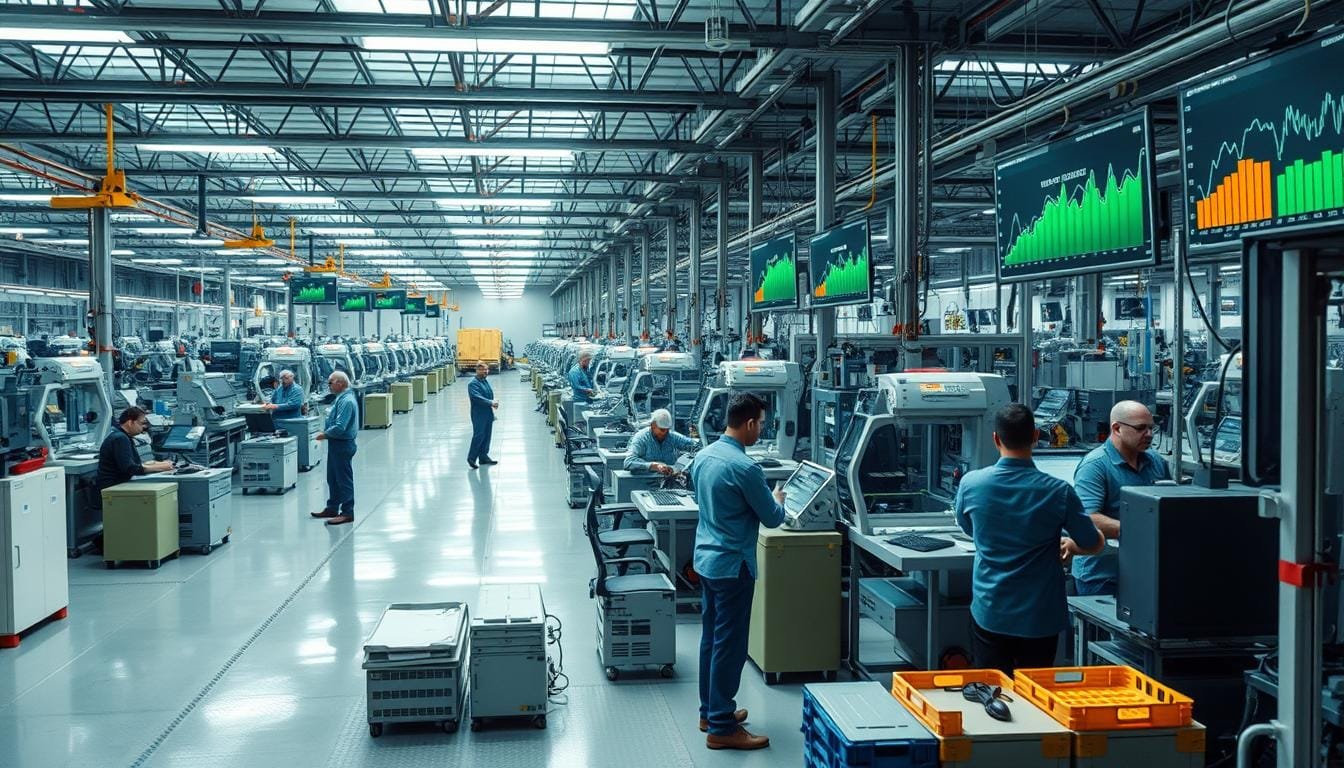The question of “how will it be produced?” is crucial in economics. It pushes us to carefully think about economic production decisions. We must choose the best mix of resources to make goods and services. This happens under the conditions of scarcity and choice. Our guide helps you navigate these complex choices. It includes weighing opportunity costs and the impact of new technology in production.
We will dive into market signals and frameworks like the Production Possibility Frontier. We also look at how different economic systems work. Through real case studies, we provide practical insights into these concepts. This makes the theory come alive and understandable.
Key Takeaways
- Scarcity and choice guide economic production decisions worldwide.
- Knowing about resources—natural, human, capital, and entrepreneurship—is key for resource allocation strategies.
- Opportunity cost matters when choosing production methods.
- The balance of what people want and what’s available is vital in deciding production and consumption.
- Different economic systems give countries unique ways to produce goods.
- New technologies are constantly shaping efficiency in economics and how things are made.
Understanding Economic Production
We explore key topics like scarcity, economic choice, resource types, and opportunity cost in production. These concepts help us understand how resources are allocated in a demanding world.
The Role of Scarcity and Choice
Scarcity economics plays a big role in our decisions because resources are limited. Our needs and wants are endless. Making economic choices is about finding the best way to use scarce resources. This affects areas like healthcare, education, and infrastructure, highlighting the need for smart decision-making.
Types of Resources in Production
- Land: A key element, it includes natural resources used in production.
- Labor: Represents human effort. Economists like Adam Smith have highlighted its value in the economy.
- Capital: Covers tools, machinery, and technology needed for making goods. For example, computers and factory equipment.
- Entrepreneurship: The drive to combine resources creatively, leading to new businesses like Meta and Starbucks.
Principles of Opportunity Cost
The opportunity cost principle is key to understanding economics. It’s about comparing the benefits of different choices. When we choose one option over another, the second-best choice is the opportunity cost. This concept is crucial for making smart business decisions. It aids in improving efficiency and strategic planning in companies.
Deciding What to Produce
When figuring out what to produce, we look at several important factors. We weigh consumer needs, resource availability, and the push for sustainability.
Consumer Demand and Resource Availability
We start by looking at what people want. This is key in deciding what to make. We match this demand with what resources we have.
This way, we make sure to meet needs efficiently and responsibly. It’s about finding the best fit between demand and supply.
Sustainability and Future Needs
With resources being limited, we must focus on sustainable use. We aim to meet today’s needs while protecting resources for tomorrow. Our plans try to balance what people need now with keeping the environment safe for future generations.
| Economic System | Focus on Consumer Demand | Approach to Resource Sustainability |
|---|---|---|
| Traditional Economy | Low (Needs-based) | Variable, often low |
| Command Economy | Low (State-determined) | High (State-controlled resources) |
| Planned Economy | Moderate (State-determined with some market response) | High (Planned resource allocation) |
| Market-Based Economy | High (Demand-driven) | Moderate to High (Driven by consumer preferences and regulations) |
| Mixed Economy | High (Balanced state and market demand) | High (Balanced market dynamics and state regulation) |
With careful planning and a focus on sustainability, we ensure our production choices are good for today and the future. By taking this full view, we aim to build an economy that works for both current and future generations.
How Will It Be Produced in Economics
To understand how goods and services are made, we look at production methods and economic efficiency. These choices affect the economy’s health. They decide if an economy will thrive or not.

Economic efficiency relies on thorough cost-benefit analysis. This compares what you put in to what you get out. It decides if a production method is good or not. For example, shifting to advanced technology in production is often highlighted. A deeper dive into total, margin, and average product is key. It helps make better choices. For more, check out these production concepts.
The impact of these choices is clear worldwide. Take China, for instance. It moved from a strict command system to a market system. This change pushed its agricultural production up by 42 percent from 1978 to 1984. It shows how essential adaptable production methods are.
| Country | Economic System | Key Production Outcomes |
|---|---|---|
| USA | Mixed | $2 trillion spent on social services (2011) |
| China | Transitioning Market | 42% increase in agricultural production (1978-1984) |
| Cuba | Command | 95% underground economy participation |
| North Korea | Central Planning | Emergence of farmers’ markets post-reforms |
Choosing how to make goods is all about the pros and cons of different production methods. This decision-making ensures economic efficiency. It forms the base of cost-benefit analysis. This is vital for an economy to grow and stay healthy.
Economic Systems and Production Methods
Understanding how societies manage production and distribution is crucial. We must grasp the differences among market, command, and mixed economy systems. Each brings its own approach to economic production.
Comparing Market, Command, and Mixed Economies
In a market economy, the market largely decides production matters. Here, there’s little government input. The focus is on individual entrepreneurship and consumer choice. These factors greatly influence production and prices.
A command economy, on the other hand, sees government taking a central role. It controls what to produce, the quantity, and the price. This can include essential national resources.
Mixed economy systems integrate features from both market and command economies. In these systems, the government steps in to ensure social goals. Yet, it also permits market forces to guide some economic decisions.

Each system has its pros and cons. For example, market economies encourage innovation through competition. Command economies, however, can focus efforts on vital national projects efficiently.
Mixed economies are the most common worldwide. They offer a balance. There’s room for private sector ingenuity and necessary government regulation for societal needs.
Government’s Role in Production
The government’s influence ranges broadly across different systems. In command economies, it makes key production choices. It might own or operate major resources for the public good.
In market economies, government’s focus is to ensure fair play. It establishes rules to stop unfair business actions. Mixed economies see the government both regulating and participating in the economy. It aims to marry economic efficiency with fairness.
Grasping these economic systems enlightens us about how production and allocation shape our world. With this knowledge, we can make better choices within our economic contexts.
Maximizing Efficiency: The Production Possibility Frontier
The production possibility frontier (PPF) is key in grasping economic efficiency and potential. It shows the max output of two goods with limited resources. This illustrates the tough choices and trade-offs shaping our economy. Let’s look at how the PPF helps in getting the most from resources and boosting economic growth.

The PPF model showcases efficiencies and inefficiencies well. Being on the frontier means using resources in the best way possible. Producing more of one good means less of another, showing opportunity cost. If you’re inside the curve, it means resources aren’t fully used. And beyond the curve is out of reach with what we have now.
Economic growth moves the PPF forward. More resources or better tech push the frontier out. This lets us make more of both goods. It shows an economy growing stronger and is key for smart economic planning.
| Production Option | Textbooks | Computers |
|---|---|---|
| Option 1 | 100 textbooks | 0 computers |
| Option 2 | 80 textbooks | 15 computers |
| Option 3 | 50 textbooks | 30 computers |
| Option 4 | 20 textbooks | 40 computers |
| Option 5 | 0 textbooks | 50 computers |
The table shows different mixes of textbooks and computers made by a nonprofit. Different mixes show various outcomes. This helps leaders find the best way to use resources and improve results.
The PPF is a powerful tool in both micro and macroeconomics. It highlights key ideas like scarcity, trade-offs, and growth. It’s vital for reaching top standard in using resources and growing economically.
Impact of Technology on Production
Technology has drastically changed global production, affecting economics and efficiency. It’s clear that innovations are transforming how we produce and plan for the future production trends.
Technology greatly improves production efficiency. For example, robots and AI have made operations smoother. They’ve cut labor costs and made products more accurate. But, they also caused job losses. We must think about the social and economic effects of this.
Enhancing Efficiency and Output
Digital tech has blurred the lines between industries, impacting retail, media, and transport. Using big data and machine learning boosts operation efficiency and customer happiness. Also, 3D printing has changed production by making it quicker and cheaper. This supports a strong e-commerce system worldwide.
Future Trends in Production Techniques
The path of technological impact economics will keep changing. The growth of digital and gig economies shows new ways of producing. However, they raise issues like wage gaps and the need for fair tech access to avoid more social inequality.
To prepare for these future production trends, it’s important to understand the mix of technology, economy, and behavior. Governments and businesses need smart policies and strategies. This will help use technology for better economy and society.
Global Trade and Production Strategies
Understanding international trade economics is key to better global production planning. The idea of comparative advantage, introduced by David Ricardo and James Mill, is fundamental. It helps nations boost their economy by focusing on what they do best.
The move from local to global markets is significant. For example, European exports grew from 1% of GDP in 1830 to 10% by 1900. Today, global exports make up about 25% of global economic output. This is a big jump from less than 10% before 1870.
| Data Point | Statistics |
|---|---|
| US Trade Deficit, July 2024 | $78.8 Billion |
| Exports Growth Multiplier, 1913-Now | More than 40x |
| Global Export Value as % of GDP | 25% |
| Share of Exports and Imports in Global Output | >50% |
Trade openness varies from country to country in international trade economics. The US, for instance, relies less on trade compared to many developed countries. This shows the need for custom global production planning that matches each country’s situation.
Practices like rent-seeking illustrate the complexities in trade policies. Some industries push for protective laws. These go against the idea of free trade, which opposes such regulations. Understanding these aspects is crucial for making good trade and production policies.
Adding Foreign Direct Investment (FDI) into the mix helps a lot. It creates jobs, grows the GDP, and increases revenue. This shows how international cooperation and using comparative advantage can be very beneficial.
We are on the edge of boosting our growth by following these economic rules. By matching our production with our best skills and adjusting to the world market, we can thrive. This will make our global market more interconnected and dependent on each other.
Conclusion
Through exploring economic production decisions, we’ve found how vital managing resources and aiming for efficient production is. This knowledge is a core part of economics, which deals with the challenges of scarcity and decision-making. It encourages us to make smart choices about our future.
We have learned crucial ways on deciding what and how to produce goods and services. Whether it’s through market, command, or mixed economies. These choices impact our ability to produce valuable goods and services efficiently.
Our study shows the complexity of production. By examining how we use natural, human, and capital resources, we see the big picture. Understanding the Production Possibility Frontier helps us make important decisions about production and resource use.
By focusing on goods and services that are in high demand but scarce, we learn the importance of pricing. Pricing helps signal scarcity in the market. It guides us in making wise economic choices.
We also learned about the difference between positive and normative statements. This distinction is key in economic discussions. It helps us separate fact from opinion in our decision-making.
There are many paths to efficient economic production, each with its own challenges. But our decisions are not just about the outcome. They also reflect the society we want to build for the future. It’s important to consider both today and tomorrow.
FAQ
What are the key factors that influence economic production decisions?
Key factors impacting economic production decisions include resource scarcity and economic choice. Available production resources, technology, and opportunity cost principles also play crucial roles. These factors affect how resources are allocated and production efficiency.
How does scarcity economics affect production?
Scarcity economics means choosing how to use limited resources to meet endless wants. It requires prioritizing some goods and services, focusing on necessity, usefulness, and what’s accessible.
What types of resources are involved in production?
The main resources in production are natural and human capital, physical capital, and entrepreneurship. How these are managed influences production efficiency and outcome.
Why is understanding the opportunity cost principle important in economics?
Understanding opportunity cost is vital as it shows the cost of choices. It aids in decision-making, ensuring resources are used wisely and benefits surpass costs.
How do consumer demand and resource availability decide what to produce?
Consumer demand shows what society wants, while resource availability tells us what’s possible to make. They help in economic planning, aiming to balance needs with possibilities.
What is the importance of sustainability and consideration of future needs in economic planning?
Sustainability is vital to ensure that today’s production doesn’t harm future generations’ ability to meet their needs. It ensures we balance current consumption with foresight.
How do production methods affect economic efficiency?
Production methods impact economic efficiency by managing labor and capital, implementing technology, and considering costs and benefits. Effective methods improve productivity and save resources.
Why is it essential to compare market, command, and mixed economies?
Comparing different economic systems is key to understanding their approaches to production and distribution. This insight helps evaluate their impact on economy-wide efficiency, innovation, and resource distribution fairness.
What is the government’s role in production within various economic systems?
In market economies, the government primarily regulates and supports. In command economies, it directs production. Mixed economies blend market-driven and government-led production strategies.
How does the Production Possibility Frontier (PPF) aid in maximizing efficiency?
The PPF shows trade-offs in production, aiding in grasping opportunity costs. It assists in planning resource allocation for growth and efficiency.
What is the technological impact on economics concerning production processes?
Technology boosts production efficiency and leads to new goods and services. It expands the economy’s resource usage capacity, impacting the Production Possibility Frontier.
What are the expected future trends in production techniques?
Expected trends include more automation, artificial intelligence, and data analytics use. There’s also a shift towards sustainable manufacturing and better resource management.
How do global trade and production strategies interact?
Global trade lets countries focus on producing goods and services they excel at. This leads to efficient global resource use, encouraging economic cooperation and growth.
What are the primary considerations in economic production decision-making?
Decision-making in production considers resource scarcity, opportunity costs, and economic and technological factors. Goals include efficiency, growth, and sustainability alignment.
